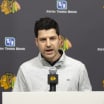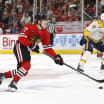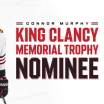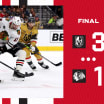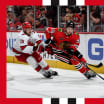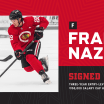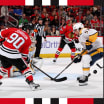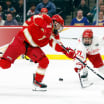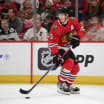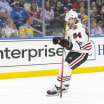There is a litany of hits, misses and tweeners since the National Hockey League Draft was instituted in 1963. So it has been, and so it will be when the United Center becomes the sport's epicenter on June 23.
The host Blackhawks, with three Stanley Cups this decade, are Exhibit A in how to build a championship core through the judicious selection of youth and skillful development of same. Having finished atop the Western Conference during the regular season, the Blackhawks will draft 26th in the first round. Their recent reign is based on exemplary selections, some of which occurred while the franchise wobbled.
Verdict: Hits, misses and tweeners all a part of draft history
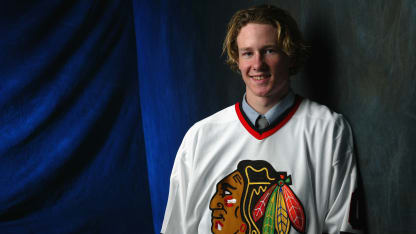
By
Bob Verdi
Blackhawks.com
Duncan Keith was picked 54th overall during the second round in 2002. Brent Seabrook, first round, 14th overall, followed in 2003. They have each earned three championship rings, as have Jonathan Toews (third overall in 2006), Patrick Kane (first overall in 2007) and Niklas Hjalmarsson (108th overall in 2005). Corey Crawford, 52nd overall behind Seabrook in 2003, has backstopped for two Cups. That is an estimable core, all hits. Had one been a miss, or even a tweener, who is to say whether the Blackhawks would have staged all those parades?
Before the NHL draft was implemented, NHL teams were built in part via sponsorships of junior clubs. That's how the Blackhawks acquired Bobby Hull and Stan Mikita. With parental consent, Bobby Orr -- at age 14 and weighing 125 pounds -- willed his rights to the Boston Bruins. Since the advent of the current system, the penalty for expending a premium draft slot on a prospect who doesn't produce is severe. All organizations have been there, Chicago included.
But the Blackhawks also have struck gold when they really needed help. In 1977, while mired in an implausible patch of losing 16 consecutive playoff games, they drafted Doug Wilson. In 1980, Denis Savard. Empty seats at the Stadium vanished. Eddie Olczyk, Dave Manson and Jeremy Roenick joined the talent pool in the '80s, a trend that, frankly, was not replicated in the '90s. Alas, there was a stretch when the Blackhawks drafted great athletes, but in the wrong sport. Once upon a forgettable time, the Blackhawks were a better golf team than hockey team.
But scouts sometimes outdo themselves. In 1978, the Blackhawks found Darryl Sutter in the 11th round, 179th overall. In 1980, after Savard, the Blackhawks grabbed Troy Murray in the third round and Steve Larmer in the sixth, 120th overall! Talk about replenishing a needy roster. Those were good years, and they might have been even better. In 1983, the Blackhawks tabbed Dominik Hasek in the 10th round, 199th overall, the 17th goalie chosen. Could he have been the answer? Alas, we'll never know. After finally making his NHL debut in 1990, Hasek got away. You can find his plaque in the Hockey Hall of Fame, not far from the space occupied by fellow Blackhawk Ed Belfour, so unwanted that he signed as a free agent. Hasek won two Cups with the Detroit Red Wings, Belfour one with the Dallas Stars. So it goes.
Such is the fickle nature of talent procurement. Some gems wait forever to be loved, but unlike Belfour, at least they were drafted. Brett Hull's name wasn't called until the sixth round. Ditto for Pavel Datsyuk and Daniel Alfredsson. Henrik Lundqvist walked the halls until the seventh round, as did Doug Gilmour and Henrik Zetterberg. Luc Robitaille scored 668 goals, and the Los Angeles Kings didn't bother keeping the receipt. They stole him in round nine. In this year's Stanley Cup Final, rosters of the Pittsburgh Penguins and Nashville Predators were liberally sprinkled with distant draftees.
Well north of that, there have been instances when No. 1 draft choices were traded, even before being identified. How the Montreal Canadiens perpetuated their dynasty is a classic example. Prior to the 1970-71 season, General Manager Sam Pollock coveted the top choice in that spring's draft. Pollock was a genius. It was admiringly theorized that, had he been an undertaker, Pollock could convince a bereaved family to purchase a suit with two pairs of pants for the parting outfit of a deceased soul.
Anyway, the Canadiens won the 1971 Stanley Cup in a momentous seven-game series against the Blackhawks, a fitting swan song for the great Jean Beliveau, age 39. Yet, a month later, there was Pollock holding the No. 1 overall selection. You ask, how? Well, in a typically astute bit of pre-planning, Pollock envisioned the expansion California Golden Seals as a good bet to be bad. So, he convinced Seals owner Charles O. Finley to accept Ernie Hicke and a 1970 draft choice in exchange for California's No. 1 slot in 1971.
The Seals had to log the NHL's worst record to make it work, and they obliged with room to spare. (In another Pollockpalooza, he shipped Ralph Backstrom to the struggling Los Angeles Kings mid-season, just to fortify their chances of not underwhelming the Seals.) On draft day, the Stanley Cup champions had a pleasant dilemma. Guy Lafleur or Marcel Dionne? Pollock selected Lafleur, a sure superstar. He won five Cups in Montreal. Dionne went No. 2 to the Detroit Red Wings. They are both in the Hall of Fame.
And so is Pollock.


